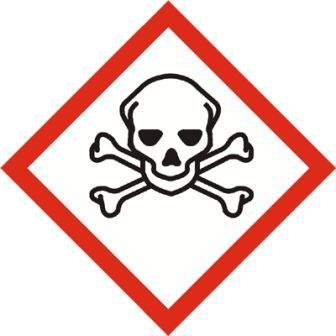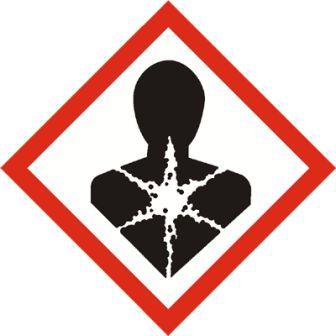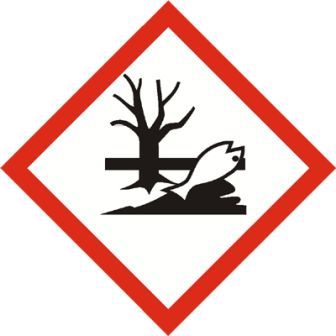Safety data sheet
According to Regulation (EC) No 1907/2006
ZnSe, crystalline
Version 1.1 / EN Updated at: 20.02.2024
1. Name of the substance and of the company
1.1 Product identification
Product number:
| xxx xxx
|
Substance name:
| Zinkselenid ZnSe, kristallin
|
EG-Nr.:
| 215-259-7
|
REACH Registration number:
| currently exempt from registration (Titel II, Art.6, Abs.1 REACH)
|
CAS-Nr.:
| 1315-09-9
|
1.2 Relevant use of the substance and uses advised against
Identified use: Exclusively for use as a material for optical components.
1.3 Company designation
VONJAN Technology GmbH
Neubruch 4
82266 Inning am Ammersee
Fon.: +49 (0) 8143 999 83 50
Fax: +49 (0)8143 999 83 55
E-Mail: info@vonjan-tech.de
1.4 Emergency information
Germany:
| POISON CONTROL CENTRE-NORTH Göttingen, 24h/7d
| Fon.: +49-(0)551 19 240
|
Austria:
| POISON INFORMATION CENTRE Vienna, 24h
| Fon.: +43,(0)1 406 43 43
|
Switzerland:
| TOX INFO SUISSE Zürich
| FON.: +41 44 251 51 51
|
2. Potential hazards
2.1 Classification of the substance
2.1.1 According to regulation (EG) 1272/2008 (CLP)
Category:
| Acute toxicity Ingestion
| Category 3 H301
|
Category:
| Acute toxicity Inhalation
| Category 3 H331
|
Category:
| Specific target organ toxicitiy (repeated exposure)
| Category 2 H373
|
Category:
| Hazardous to waters, Acute
| Category 1 H400
|
Category:
| Hazardous to waters, Chronic
| Category 1 H410
|
2.1.2 Other information
EUH032 Contact with acids liberates very toxic gas.
2.2 Identification elements
Pictograms:
| |
Signalword:
| DANGER
|
Hazard warnings:
| 301 Toxic if swallowed. H331 Toxic by inhalation. H373 May cause damage to organs through prolonged or repeated exposure. H410 Very toxic to aquatic organisms with long lasting effects.
|
Safety advice:
| P260 Do not breathe dust/fume/gas/mist/vapour/aerosol. P264 Wash hands and skin thoroughly after use. P270 Do not eat, drink or smoke when using this product. P273 Avoid release into the environment. P301+P310 In case of ingestion: Immediately call a POISON CENTRE or doctor. P304+P312 IF INHALED: If you feel unwell, call a POISON CENTRE or doctor
|
2.3 Additional hazard information
The substance can form the very toxic gas hydrogen selenide H2Se in contact with acids. The criteria for vPvB according to Annex XIII of Regulation (EC) No 1907/2006 REACH do not apply to this substance. The substance is not listed as a particularly hazardous substance (SVHC) according to Annex XIV of Regulation (EC) No 1907/2006 REACH. The substance is listed as a hazardous substance according to Annex VI, Table 3.1 of Regulation (EC) No 1272/2008 CLP-GHS
3. Composition / information on ingredients
3.1 Substances
Name
| Sum formula
| Wt. % content
| CAS-No.
| (EG)EINECS-No.
| Index-No. in CLP Annex VI
| UN-No.
|
Zinkselenid
| ZnSe
| 100
| 1315-09-09
| 215-259-7
| 034-002-00-8
| 3283
|
4. First aid measures
4.1 Description of the first aid measures
General remarks:
| Visit a doctor for a thorough examination.
|
After inhalation:
| Get fresh air and call a doctor. If breathing stops, give artificial respiration.
|
After skin contact:
| Pick up dust with dry cellulose. Clean immediately with plenty of water and soap. Remove contaminated clothing immediately and store in closed container like contaminated materials. |
After eye contact:
| Rinse with plenty of water when eyelid is open.
|
After ingestion:
| Do not induce vomiting. Rinse mouth and give 2 cups of water to drink if person is conscious. Call a doctor. |
Self-protection first aider:
| Accordingly, to avoid substance contact.
|
4.2 Most important symptoms and effects, both acute and delayed
Eye burning, skin scratching (dermatitis) after prolonged contact, metallic taste and runny nose ("selenium rhinitis"), coughing and scratching in the throat when inhaled, nausea up to and including vomiting, dizziness, headache. Formation of pulmonary oedema, CNS disorders, cardiac arrhythmias, liver and kidney damage possible.
4.3 Indications for immediate medical help or special treatment
Highly toxic hydrogen selenide and selenium dioxide may be formed by decomposition reactions in the stomach. Selenium intoxications may be recognisable by a metallic taste in the mouth and a garlicky odour in the breath. BAL and Ca-EDTA treatments are unsuitable for the treatment of selenium intoxications. For pulmonary oedema prophylaxis, the application of glucocorticoids is recommended.
5. Fire fighting measures
5.1 Extinguishing agent
Suitable extinguishing media: Water spray, foam, carbon dioxide (CO2), extinguishing powder according to the environment.
Unsuitable extinguishing media: none
5.2 Special hazards caused by the substance, its combustion products or resulting gases
Hazardous combustion products: At temperatures >400°C formation of toxic/corrosive vapours of Zn, ZnO, Se, SeO2, H2Se (zinc, zinc oxide, selenium, selenium dioxide, hydrogen selenide) possible.
5.3 Advice for firefighters
Self-contained breathing apparatus, full protective clothing to avoid skin contact. Precipitate escaping gases/vapours/mist with water. Do not allow extinguishing water to reach surface water, groundwater or sewage system.
6. Accidental release measures
6.1 Personal precautions, protective equipment and emergency procedures
6.1.1 Staff not trained for emergencies
Protective equipment: Suitable protective clothing and equipment.
Procedures to be applied: Avoid dust formation and do not inhale dusts. Ensure adequate ventilation. Avoid contact with eyes and skin.
6.2.1 Task forces
Use PVA gloves.
6.2 Environmental protection measures
Do not allow to enter drains or groundwater. Notify authorities if necessary.
6.3 Methods and material for containment and cleaning
6.3.1 Restraint:
Take up immediately and transfer to suitable container with labelling.
6.3.1 Cleaning:
Take up dry and avoid dust formation. Clean with a damp cloth.
6.3.2 Other information:
none
6.4 Reference to other sections
Protective clothing according to SECTION 8, disposal according to SECTION 13.
7. Handling and storage
7.1 Protective measures for safe handling
Protective measures:
| Observe general hygiene and safety measures.
|
Prvention of fires:
| Keep away from heat sources.
|
Prevention of aerosol and dust formation:
| Extraction required for dust-producing activities. Protect from mechanical damage. Avoid dust formation. |
Protection of the environment:
| Leftovers must be placed in collection containers.
|
Hygiene at the workplace:
| Wash hands well after contact.
|
7.2 Conditions for safe storage taking into account incompatibilities
Technical measures and storage conditions:
| Only accessible to competent persons. Keep away from food foodstuffs. Do not mix with acids and strong bases. |
Packaging materials:
| Not critical.
|
Requirements for storage rooms and containers:
| Dry, well-ventilated places. Containers should be tightly closed and be labelled. |
Storage class (VCI):
| 6.1D: non-flammable, acutely toxic substances cat. 3 or chronically acting
|
Further Information:
| None
|
7.3 Specific end applications
Optical material for the exclusive manufacture of optical components.
8 Limitation and supervision of exposure / Personal protective equipment
8.1 Parameters to be monitored
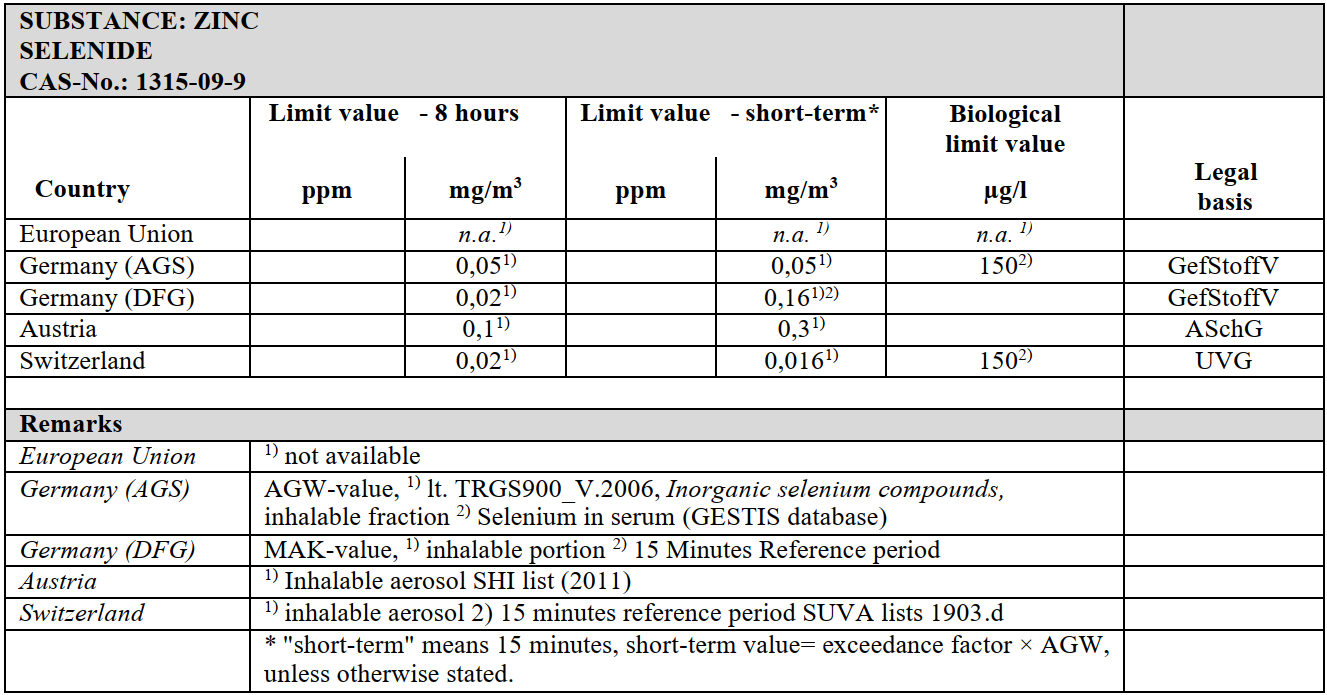
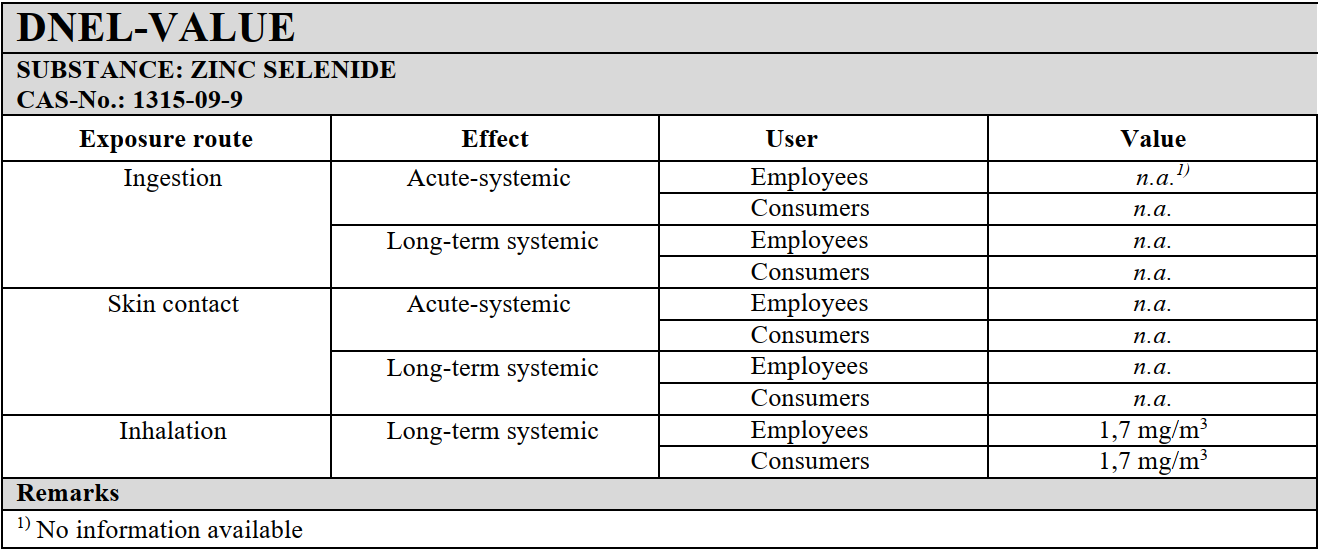

8.2 Exposure controls and monitoring
8.2.1 Suitable technical control devices
Substance-related measures for identified uses: Keep only required quantities of substances at the workplace.
Organisational measures: Annual instruction of employees. Comply with AGW.Observe employment restrictions for young people as well as expectant and nursing mothers in accordance with the relevant legal texts.
Technical measures: Ensure sufficient ventilation or extraction.
8.2.2 Personal protective equipment
Eye/face protection: Wear laboratory goggles with side protection.
Hand/skin protection: Wear tightly fitting protective clothing or a chemical suit. Gloves made of PVA. Observe skin care.
Respiratory protection: When high dust concentrations occur, wear combination filter type B-P3, identification colour: grey-white.
Thermal hazards: not applicable
8.2.3 Limitation and monitoring of environmental exposure
Substance-related measures: Keep only required quantities of substances at the place of use.
Instruction measures: Do not allow to enter the sewage system. Use collection containers.
Organisational measures: Set up collection containers at the place of use.
Technical measures: No drainage at the place of use
9. Physical and chemical properties
9.1 Information on the basic physical and chemical properties
a) Appearance: reddish/yellow, geometric bodies
b) Smell: odourless
c) Odour threshold: not applicable
d) pH-Value: not applicable
e) Melting point/freezing point: 1526°C
f) Initial boiling point and boiling range: not known
g) Flash point: not known
h) Evaporation rate: not known
i) Flammability (solid, gaseous): not known
j) Upper/lower flammability or explosion limits: not known
k) Vapour pressure: negligible (25°C)
l) Dampfdichte: not known
m) Spezifische Dichte: 5,3 g/cm3 (20 °C)
n) Löslichkeit(en): practically insoluble in water (20°C)
o) Verteilungskoeffizient: n-Octanol/Wasser not known
p) Selbstentzündungstemperatur: not known
q) Zersetzungstemperatur: > 400°C
r) Viskosität: Plastic deformable from 500°C
s) Explosive Eigenschaften: not applicable
t) Oxidierende Eigenschaften: none
9.2 Other information
Oxidises above 300°C.
10. Stability and reactivity
10.1 Reactivity: Reacts with acids, strong bases and strongly oxidising substances.
10.2 Chemical stability: Stable when handled and stored as intended.
10.3 Possibility of hazardous reactions: Gas formation with inorganic acids.
10.4 Conditions to avoid: Acids, oxidising substances, temperatures >700°C.
10.5 Incompatible materials: Strong inorganic acids, bases and strongly oxidising substances.
10.6 Hazardous decomposition products: Formation of gaseous, very toxic hydrogen selenide (H2Se) and selenium dioxide (SeO2)
11. Toxicological information
11.1 Information on toxicological effects
- Acute toxicity: Threshold concentration for toxic effects: 44.5mg/m3 inhalation in rats.
- Skin corrosion/irritation: Prolonged contact dermatitis.
- Serious eye damage/irritation: Mechanical irritation.
- Respiratory/skin sensitisation: Cough irritation, runny nose.
- Carcinogenicity: Suspected based on animal studies with high doses of selenium sulphide and sodium selenate.
- Germ cell mutagenicity: Substance-specific data not available. For various genotoxic potential for high doses has been demonstrated for various selenium compounds.
- Reproductive toxicity: Substance-specific data are not available. If the MAK or BAT value is adhered to, no consequences are to be expected. BAT value, no consequences are to be expected.
- Assessment of CMR properties: In low doses only a low hazard potential.
- Specific target organ toxicity in case of single exposure: Not known.
- Specific target organ toxicity in case of repeated exposure: Liver, lungs and kidneys, nervous system.
- Aspiration hazard: Risk of developing pulmonary oedema.
12. Environmental information
12.1 Toxicity

12.2 Persistence and degradability
Abiotic degradation: Data not known
Biotic degradation: Data not known
12.3 Bioaccumulative potential
Octanol/water partition coefficient (log Kow): Data not known
Bioconcentration factor (BCF): Data not known
12.4 Mobility in soil
Data not known
12.5 Results of the PBT and vPvB assessment
Does not apply to the fabric.
12.6 Other adverse effects
Data not known
13. Notes for disposal
13.1 Waste treatment process
- Safety advice according to REACH: P501 Dispose of contents / container in accordance with local / regional / national / international regulations.
- Substance: Leave in original container and do not mix with other wastes. Handle as hazardous waste according to local / national safety regulations and laws.
- Packaging: Contaminated packaging is to be handled like the substance, cleaned materials can be disposed of with household waste.
- Waste code according to AVV: 16 03 03 Inorganic waste containing dangerous substances
15 01 10 Packaging containing residues of or contaminated by hazardous substances - Waste code according to LoW: corresponds to AVV code
- Other recommendations: Waste should not be disposed of via waste water
14. Transport information
14.1 UN-Number: 3283
14.2 UN proper shipping name: Selenium compounds, solid, n.o.s. (zinc selenide).
14.3 Transport hazard classes: 6.1 (Hazard substances)
14.4 Packing group: II (medium hazard)
14.5 Environmental hazards: Ocean pollutant
14.6 Special precautions: none
14.7 Bulk transport MARPOL / IBC: Data not known
15. Legislation
15.1 Safety, health and environmental regulations/specific legislation
EU-Regulation
REACH- Ordinance 1907/2006, Art.57: No substance of very high concern according to SVHC list
SEVESO3- Directive 2012/18/EU: Annex I, T.1, para H2 Acute toxic Cat.2-3 Sp.2/3 50/200t, Annex I, T.1, para E1 Harmful to the aquatic environment Sp.2/3 100/200t
RoHS- Directive 2011/65/EU: Not listed in the substance list
Employment restrictions: Observe the Youth Employment Protection Act (94/33/EC). Observe Maternity Protection Directive (EC 92/85/EEC)
National regulations
Water hazard class WGK: WGK 3 highly hazardous to water
Technical Instructions on Air Quality (TA-Luft): Dusty inorganic substances, Class 2: max. 2.5g Se/h or 0.5mg Se/m3
Major Accidents Ordinance (12.BImSchV): see above SEVESO3 EU Directive
Employment restrictions: for young people according to § 22 JArbSchG for expectant and nursing mothers according to §§ 4 & 5 MuSchRiV
Teaching in schools with hazardous substances (DGUV-Regel_113_018+019): ZnSe not listed, but for Se and SeO2 activity ban for pupils up to and including year 4*.
Non-EU regulations/chemical directories*
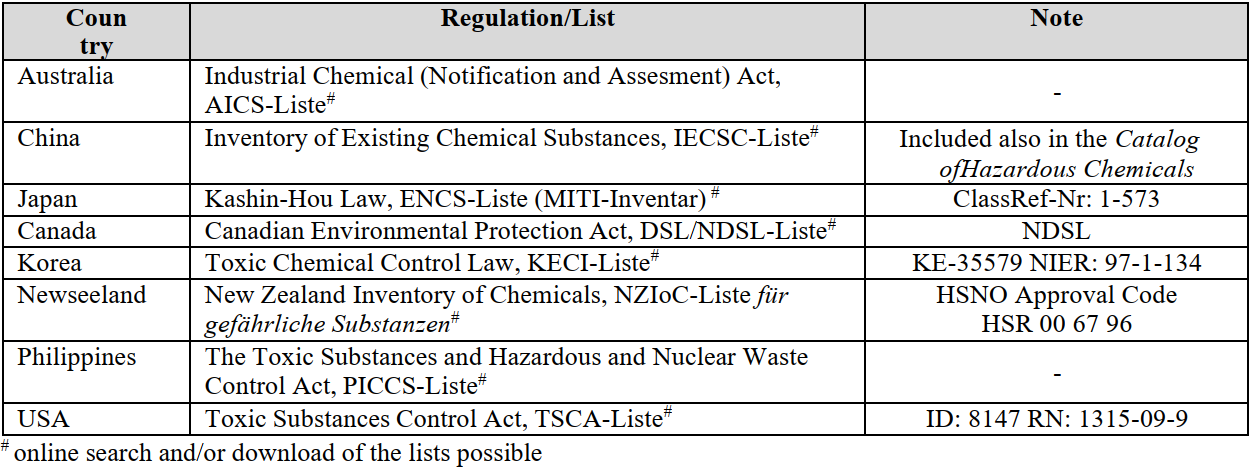
15.2 Chemical safety assessment
No chemical safety assessment has been carried out on this substance.
16. Other information
Changes in comparison to the last version (see marking *)
• none
Abbreviations used
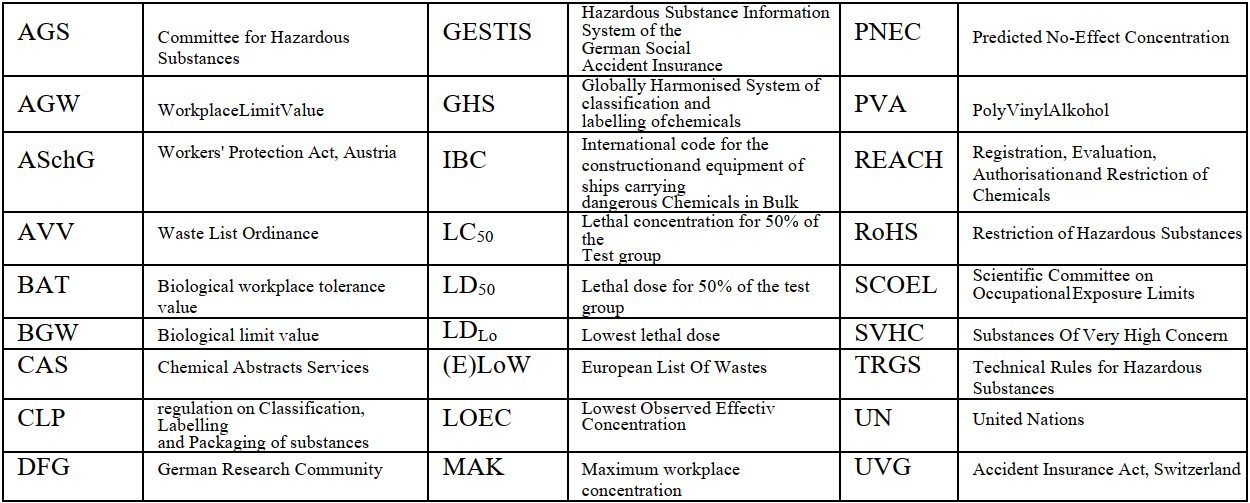

Data sources
ECHA-Leitlinie 15-G-07.1-DE: Leitlinien zur Erstellung von Sicherheitsdatenblättern, Fassung 3.1, ed.
ECHA, Helsinki 11/2015 (ISBN: 978-92-9247-514-7)
Allgemeine Ausführungen, Abkürzungen etc., Wikipedia, die freie Enzyklopädie
GESTIS-Stoffdatenbank der Deutschen Gesetzlichen Unfallversicherung DGU, Gefahrstoffe: GESTIS-Stoffdatenbank
GESTIS-Datenbank Internationale Grenzwerte für chemische Substanzen der DGU, IFA: GESTIS - Internationale Grenzwerte für chemische Substanzen
GESTIS-Datenbank DNEL-Werte der DGU, Gefahrstoffe: GESTIS-DNEL-Liste
Datenbank GEFAHRGUT der Bundesanstalt für Materialforschung und -prüfung BAM, BAM - TES - Datenbank GEFAHRGUT
Liste der SVHC-Stoffe (Stand: 12/2015) gemäß Anhang XIV der Verordnung (EG) Nr.1907/2006 REACH, Homepage - ECHA
Einstufung, Kennzeichnung und Auflistung gefährlicher Stoffe in der Verordnung (EG) Nr.1272/2008 (CLP-GHS)
Liste der RoHS-Stoffe in der Richtlinie 2011/65/EU (RoHS 2)
Informationen zu Giftnotrufzentralen weltweit, Giftinfo
MAK- und BAT-Werte in der Veröffentlichung der Schweizer Unfallversicherungsanstalt Suva: Grenzwerte am Arbeitsplatz 2015, ed. Suva - Bereich Arbeitsmedizin, 2015, Grenzwerte am Arbeitsplatz: Aktuelle MAK- und BAT-Werte
List of danger and safety instructions
EUH032 In contact with acid, emits very toxic gases.
H301 Toxic if swallowed.
H331 Toxic by inhalation.
H373 May cause damage to organs through prolonged or repeated exposure.
H410 Very toxic to aquatic organisms with long lasting effects.
P260 Do not breathe dust/fume/gas/mist/vapour/aerosol.
P264 Wash hands and skin thoroughly after use.
P270 Do not eat, drink or smoke when using this product.
P273 Avoid release into the environment.
P301+P310 In case of ingestion: Call a POISON CENTRE or doctor immediately.
P304+P312 IF INHALED: If you feel unwell, call a POISON CENTRE or doctor.
P501 Dispose of contents/container to an approved disposal facility.
The information is based on our current knowledge. This SDS has been compiled and is intended solely for this product.
